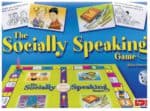10 Tips for Autism and Social Skills
The relationship between social skills and autism is complex and multi-layered. Everyone makes some social mistakes but on the whole we are quick to recognise our errors and act to repair them. However, students with autism are seriously disadvantaged socially as they have great difficulty understanding non-verbal communication, such as facial expression, body language and/or tone of voice. Their literal interpretation of language means that they frequently misunderstand the actual words. I have put together 10 Top Tips to help you when teaching social skills to students with autism

Initially, it may seem challenging to integrate social skills and autism as interpersonal skills are are complex and so much depends on ‘reading’ an individual, and adjusting to the individual situation as it evolves. We often do not realise exactly what is involved in a social skill but we immediately recognise when it is absent. When teaching social skills to students with autism many of us fall into the trap of assuming knowledge on the person with autism’s part, e.g. we fail to realise that the young student will not know that one greets friends in a different way to the school principal or even that the student will understand what the word ‘greet’ means. It is commonly known that students with autism are socially naive and have the social awareness, without necessarily the quality, of a child two or three years younger than they are.
10 Tips To Remember When Teaching Social Skills to Students with Autism
Excerpt from Developing Social Skills By Sue Larkey and Gay von Ess

Adapt activities to REAL people and places the child knows. Imagine you are talking to a teacher, friend, name a specific student – include real names of people they know.

Remember that social expectations frequently become more complex as people get older – repetition and elaboration is essential.

Tell what to do, not what NOT to do. Instad of “NO JAMES” say James wait, Sarah first”

Catch students doing ‘the right thing!’ and reward

Do not assume students with autism will generalise; they need to practice in different environments

Engage peers as they can be great role models and encourage students with autism in a range of situations.

Be a role model. Being slightly over-dramatic will help the child with autism identify points you are illustrating; e.g. body language, tone of voice, coping with mistakes.

Use visuals – For a child with autism a picture is worth a thousand words or more!

Make teaching quick and fun!

PRACTICE, PRACTICE, PRACTICE!!





































 Sorry we no longer ship items outside Australia. Please consider the digital versions of Sue’s Books –
Sorry we no longer ship items outside Australia. Please consider the digital versions of Sue’s Books – 